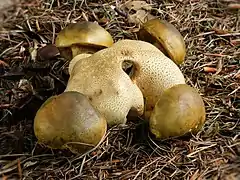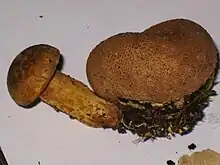Pseudoboletus parasiticus
Pseudoboletus parasiticus, previously known as Boletus parasiticus and Xerocomus parasiticus, and commonly known as the parasitic bolete, is a rare Boletaceae mushroom found on earthballs (Scleroderma citrinum). Pseudoboletus parasiticus is one of the earliest-diverging lineages of the Boletaceae, after the clade comprising Chalciporus and Buchwaldoboletus.[1]
| Pseudoboletus parasiticus | |
|---|---|
 | |
| B. parasiticus | |
| Scientific classification | |
| Kingdom: | |
| Phylum: | |
| Class: | |
| Order: | |
| Family: | |
| Genus: | |
| Species: | P. parasiticus |
| Binomial name | |
| Pseudoboletus parasiticus (Bull.) Šutara, 1790 | |
| Synonyms | |
|
Xerocomus parasiticus (Bull.) Quél., 1887 | |
| Pseudoboletus parasiticus | |
|---|---|
| Gills on hymenium | |
| Cap is flat | |
| Stipe is bare | |
| Spore print is yellow to olive | |
| Ecology is parasitic | |
| Edibility is not recommended | |

Pseudoboletus parasiticus
Description
The cap is hemispherical when young, later flat, yellowish brown or darker and up to 5 cm in diameter. The flesh is pale yellow and the spores are olive. The stem is pale yellow to olive. While edible, it is not recommended to do so.[2]
References
- Nuhn ME, Binder M, Taylor AF, Halling RE, Hibbett DS (2013). "Phylogenetic overview of the Boletineae". Fungal Biology. 117 (7–8): 479–511. doi:10.1016/j.funbio.2013.04.008. PMID 23931115.
- Phillips, Roger (2010). Mushrooms and Other Fungi of North America. Buffalo, NY: Firefly Books. p. 255. ISBN 978-1-55407-651-2.
Further reading
- E. Garnweidner. Mushrooms and Toadstools of Britain and Europe. Collins. 1994.
This article is issued from Wikipedia. The text is licensed under Creative Commons - Attribution - Sharealike. Additional terms may apply for the media files.